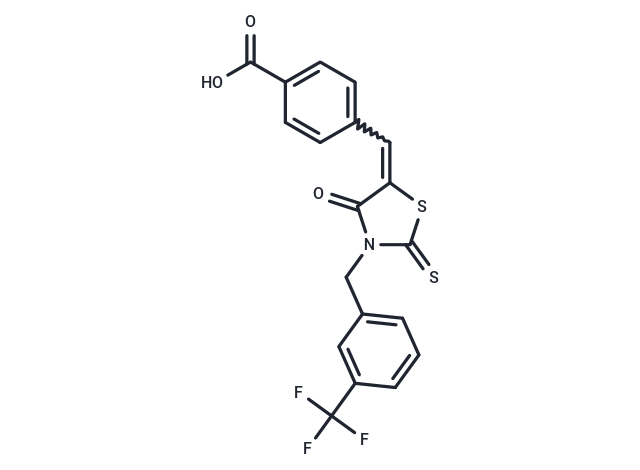Shopping Cart
- Remove All
 Your shopping cart is currently empty
Your shopping cart is currently empty

CY-09 is an NLRP3 inhibitor.

| Pack Size | Price | Availability | Quantity |
|---|---|---|---|
| 2 mg | $55 | In Stock | |
| 5 mg | $68 | In Stock | |
| 10 mg | $118 | In Stock | |
| 25 mg | $247 | In Stock | |
| 50 mg | $392 | In Stock | |
| 100 mg | $589 | In Stock | |
| 500 mg | $1,330 | In Stock |
| Description | CY-09 is an NLRP3 inhibitor. |
| In vitro | CY-09 demonstrates a dose-dependent decrease in monosodium urate (MSU), nigericin, and ATP-triggered caspase-1 activity and IL-1β release across 1 to 10 μM concentrations in LPS-primed bone marrow-derived macrophages (BMDMs). It effectively prevents cytosolic LPS-induced noncanonical NLRP3 activation in BMDMs. Notably, CY-09, like MCC950, selectively curbs NLRP3 inflammasome activity without impacting LPS-induced priming effects. Additionally, CY-09 significantly hinders nigericin-induced ASC oligomerization and disrupts Flag-NLRP3 and mCherry-NLRP3 interactions in HEK-293T cells, indicating a blockage of NLRP3 oligomerization by CY-09. |
| In vivo | Compare with MCC950, CY-09 treatment?in vivo?efficiently suppresses monosodium urate (MSU) injection-induced IL-1β production and neutrophil influx, suggesting that CY-09 can block MSU-induced NLRP3 inflammasome activation?in vivo. CY-09 treatment also increases the survival of?NLRP3mutant mice up to days 30 to 48 even after treatment is stopped at day 25. The caspase-1 cleavage observed in adipose tissue of HFD-treated mice is also suppressed by CY-09 |
| Kinase Assay | For ATPase activity assay, purified recombinant human proteins are incubated at 37°C with indicated concentrations of CY-09 for 15 min in the reaction buffer. ATP (25 μM) is then added, and the mixture is further incubated at 37°C for another 40 min. The amount of ATP converted into adenosine diphosphate (ADP) is determined by luminescent ADP detection with ADP-Glo Kinase Assay kit according to the manufacturer's protocol. The results are expressed as percentage of residual enzyme activity to the vehicle-treated enzyme. For ATP binding assay, purified NLRP3 proteins are incubated with ATP binding agarose for 1 h and then different concentrations of CY-09 are added and incubated for 2 h with motion at 4°C. Beads are washed and boiled in loading buffer. Samples are subjected to immunoblotting analysis[1]. |
| Cell Research | To induce NLRP3 inflammasome activation, 5×105/mL BMDMs and 6×106/mL PBMCs are plated in 12-well plates. The following morning, the medium is replaced, and cells are stimulated with 50 ng/mL LPS or 400 ng/mL Pam3CSK4 (for noncanonical inflammasome activation) for 3 h. After that, CY-09 or other inhibitors are added into the culture for another 30 min, and then the cells are stimulated for 4 h with monosodium urate (MSU) (150 μg/mL),?Salmonella typhimurium?(multiplicity of infection) or for 30 min with ATP (2.5 mM) or nigericin (10 μM). Cells are transfected with poly(dA:dT) (0.5 μg/mL) for 4 h or LPS (500 ng/mL) overnight. Cell extracts and precipitated supernatants are analyzed by immunoblot[1]. |
| Animal Research | For the?in vivo?experiments, CY-09 is formulated in a vehicle containing 10% DMSO, 10% Solutol HS 15, and 80% saline,WT or Nlrp3?/? mice at the age of 6 wk, with similar plasma glucose levels and body weights are randomized into different groups. For generation of high-fat diet (HFD)-induced diabetic mice, mice are fed with HFD for 14 wk. The diabetic mice are treated with CY-09 (i.p.) at a dose of 2.5 mg/kg once a day for 6 wk. The mice are maintained with HFD when used for CY-09 treatment and the subsequent experiments[1]. |
| Alias | CY 09 |
| Molecular Weight | 423.43 |
| Formula | C19H12F3NO3S2 |
| Cas No. | 1073612-91-5 |
| Smiles | OC(=O)c1ccc(C=C2SC(=S)N(Cc3cccc(c3)C(F)(F)F)C2=O)cc1 |
| Relative Density. | no data available |
| Storage | store at low temperature | Powder: -20°C for 3 years | In solvent: -80°C for 1 year | Shipping with blue ice. | |||||||||||||||||||||||||||||||||||
| Solubility Information | DMSO: 77 mg/mL (181.85 mM), Sonication is recommended. | |||||||||||||||||||||||||||||||||||
Solution Preparation Table | ||||||||||||||||||||||||||||||||||||
DMSO
| ||||||||||||||||||||||||||||||||||||

Copyright © 2015-2025 TargetMol Chemicals Inc. All Rights Reserved.